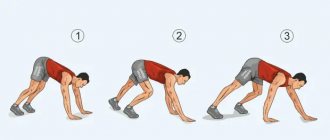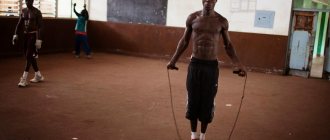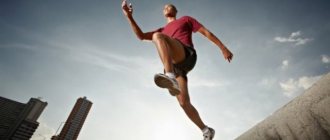Sports have firmly entered the lives of the younger generation - now it is no longer fashionable to visit clubs and stay in bars until the morning; people prefer to spend their free time in fitness clubs or on active walks.
However, sedentary work, long hours of traffic jams, and lack of fresh air still have a detrimental effect on well-being and overall stamina - now the average person can hardly cover a distance of 5 kilometers, while for our parents 10 kilometers was a completely feasible distance. To lead an active life and regularly engage in intense sports, trainers suggest starting with endurance exercises.
How quickly does endurance drop without training?
Pretty fast. “Much faster than muscle mass,” notes Oksana Khodorovich, personal trainer, group program instructor at the Escalada fitness club . —Endurance adaptation alters the metabolic environment in cells without the need for global tissue remodeling that is required for strength adaptation. You quickly get into shape, maintain it without problems, but it disappears just as easily.”
How quickly does stamina decrease? The experts' conclusions are disappointing. “It happens differently for everyone. Many researchers in the field of sports physiology agree that the first signs of loss of endurance are noticeable after 7-10 days of inactivity, comments Oksana Khodorovich. “During these days, the ability to move for a long time at low or medium intensity drops by 3-5%. As doctors discovered, first of all, the ability of the cardiovascular system to perform such work decreases. That is, you can either move slower by this 3-5%, or at the same speed your heart rate will be higher by 3-5%. After three weeks this difference will be 10%, after four – 14%.”
That's why it's important to train and develop your endurance at home .
Development of physical strength. Types of strength and how to train them
Who is a strong person?
Personally, for a long time, the concept of “strongman” was associated with a bear-like person with an impressive body mass and capable of moving a huge boulder from one place to another. Well, that is, a classic example of a Strong man competition participant.
Am I right in the end? Partly. Strength is a multifaceted quality that is not manifested by any one ability under any specific conditions. Everything is much broader and more complex.
Today we will deal with such a quality as physical strength, we will figure out what it is like to be a physically strong person and whether everyone can set records in strength exercises.
To begin with, I would like to focus on the fact that the process of physical training has 2 sides - the development of physical qualities (there are only 4 of them - strength, speed, agility and flexibility) and the improvement of motor skills (bar snatch, long jump, etc. .). In addition, I would like to clarify one golden rule of sports longevity: it is better to lift less, but technically, than a lot, but in a stooped dog pose.
In order to perform exercises technically and safely, you cannot do without proper training of muscle strength, creating a strong muscle corset around the spine, strengthening ligaments and tendons, developing joint mobility and other aspects. But in order to be strong, you need to think and develop all the above points, and not stupidly lift the barbell like the last time.
It won’t be shorter, now there will be a lot of hopefully not boring theory, let’s go)
Does everyone need strength and why?
Strength is the ability to withstand or overcome external resistance through muscular effort.
By the way, strength is not only about the barbell and traction of locomotives along the rails, holding the cable with your teeth.
External resistance can be the athlete’s own weight, external weight, environmental resistance (water, wind), support reaction force, resistance of a partner, springs or rubber, inertial force of other bodies.
This is the answer to the question whether everyone needs to develop strength and whether only in strength sports it is necessary to take care of strong muscles and strong bones.
The average person, for example, needs to be a strong guy in order not to collapse to the ground, carrying heavy bags of five, if the wind suddenly blows.
If we consider strength from the point of view of maintaining or restoring health, then strong muscles are the guarantee that your back will not crack prematurely: for example, speaking of intervertebral hernias, it is known for certain that strong and developed muscles surrounding the spine help reduce pain symptoms and significantly improve the quality of life. This is why athletes with IVD hernias who do strength training tend to feel much better than untrained people.
I won’t even describe why CrossFitters need to train strength, because those in the know understand that this is one of those qualities that is often tested in various tasks, and even in the pre-fatigue mode.
Representatives of seemingly “non-strength” sports need this motor quality at least in order to be able to cope with their own body weight.
Representatives of various sports - triathletes, acrobats and others - often neglect general physical training and, in particular, strength training, engaging exclusively in special exercises.
Yes, of course, one trains what one trains, but injury prevention and an integrated approach to sports training have not been canceled.
What does it take to be strong? Anatomical and physiological factors
Here are some dependencies:
1.The larger the size of the muscles, the greater their strength. By the way, the strength of a muscle is also affected by the number of muscle fibers (the calf has, for example, more than a million).
Strength training leads to an increase in the cross-sectional area of the muscle and, accordingly, to the development of strength (there is no increase in the number of muscle fibers). But the size of the cross-sectional diameter of the muscle fiber is not the main indicator of muscle strength.
Muscle volume grows faster than strength grows, and this needs to be understood.
And without special strength training, this quality will not be easy to develop.
But nevertheless, muscle hypertrophy is important, and it also needs to be monitored.
2. Place of muscle attachment: the farther a muscle is attached from the joint, the easier it is for it to lift weights (genetic moment). However, Andrew Vigotsky's research shows how the angles of the muscles change as muscle size increases and how this allows for greater force.
3. Another genetically determined and highly individualized point is the ratio of the type of muscle fibers within one muscle. Let me briefly remind you that there are slow, non-fatiguing fibers (capable of withstanding long-term loads of a moderate nature), there is an intermediate type, and there are white fast-twitch, but fatiguable muscle fibers (capable of exerting great strength, but not for long)
4. The frequency of discharges coming from the central nervous system to the motor unit (motoneuron + muscle fibers), as well as the number of active motor units and the synchronicity of the motor units.
If we talk about the number of active MUs, then their recruitment during work occurs in a special order: first, S-type MUs are recruited (in slow, non-fatiguable fibers), then FR type (intermediate type of fibers) and, last but not least, FF-type MUs contained in fast white muscle fibers These same white fast muscle fibers are very important from the point of view of developing muscle strength: this is why it is impossible to effectively increase strength by working with small weights: the necessary motor units simply do not have time to be recruited and an increase in strength indicators may not occur.
5. General anthropometry (length of the limbs, ratio of the length of the lower leg to the thigh, etc.) of a person can influence the manifestation of strength in individual exercises, but during observation it is difficult to isolate the influence of this factor separately from all others.
6. There is also a theory that with increasing training, the quality of the connective tissue that transmits force from muscles to bones increases. And in general, with training experience and improved technique, strength indicators become better, at least because the nervous system learns to competently and ergonomically solve a motor task.
What is power? Classification.
As mentioned above, strength is the ability to overcome or resist external resistance.
Based on the type of application, the following types of force are distinguished:
- Maximum strength is the maximum force exerted by the neuromuscular system;
- Explosive strength (speed-strength type of activity) - the ability to develop maximum strength in a minimum time;
- Power endurance is the ability to resist enlistment while maintaining a high power level.
Based on the type of muscle function, the following are distinguished:
- Eccentric strength is the force manifested in the inferior mode of muscle work (when lengthening the muscle)
- Concentric force is the force manifested in the overcoming mode of muscle work (during contraction) of the muscle.
- Holding force is the force exerted during isometric muscle work (static tension), without changing the length of the muscle.
Relative to body weight:
- Absolute strength - independent of body weight
- Relative strength is absolute strength divided by a person's body weight. Relative strength is absolute strength divided by a person's body weight. For example, a person weighing 50 kg did a maximum deadlift of 100 kg, so 100 kg/50 kg = 2 kg per kilogram of body weight
Absolute strength and relative strength: what is the difference and why are weight categories needed in sports.
Absolute strength (maximum) - the maximum effort that an athlete can develop in a particular exercise in order to overcome external resistance (dynamic mode) or resist it (static mode)
Let me remind you that strength indicators do not depend solely on muscle adaptation (hypertrophy), the adaptation of the musculoskeletal system as a whole plays a decisive role here. Increased strength can occur without muscle growth, but not without changes in the nervous system.
This is why in children, for example, strength can develop without noticeable muscle hypertrophy.
Here we are talking about improving intramuscular coordination (involvement of a larger number of motor units in the process of work (what a motor unit is was mentioned earlier) and intermuscular coordination, that is, optimizing muscle work in the process of performing a motor task (improving exercise technique during training).
Relative strength is usually compared in order to objectively assess the capabilities of athletes: participants of the same weight lift a barbell in the deadlift, but the first athlete will lift 150 kg, and the second - 160. That is, the second athlete will show greater strength in relation to the barbell. relative strength.
It is on this principle that weight categories in weightlifting, powerlifting, and martial arts are based. To become relatively stronger, an athlete needs to improve his strength results, while remaining in his usual weight category.
In CrossFit, as we know, when performing competitive exercises, the athlete’s weight is not taken into account, so the success of the task when moving weights especially depends on absolute strength indicators.
How to become stronger? Methods for developing absolute strength
Before moving on to methods for developing absolute strength, I would like to note that the development of strength qualities of various directions should be carried out in close combination with each other, as well as in harmonious collaboration with other physical qualities.
According to Yu.V. Verkhoshansky, two main methods of training absolute strength can be distinguished:
- Method of repeated efforts (here you can also include the method of progressively increasing resistance, which consists of increasing working weights with increasing level of training).
To develop strength, a scheme is used that includes 3-4 approaches with a weight of 70-80% of the maximum maximum in the number of 5-6 repetitions. In this case, the guideline should be placed not on percentages, but on the ability to perform the exercise exactly 5-6 times.
To achieve a good training effect, you need to combine different paces (fast, medium, slow) of exercises in your training sessions. Vorobiev A.G. calculated that the optimum for increasing strength is lifting in the range of 6 to 1 RM with rest intervals between workouts of at least 2 days.
This method is good when great force is required, but the speed of its manifestation is not so important. It is worth considering that muscle mass when training with weights of about 90-95% of RM in limited numbers of repetitions increases strength, but the increase in muscle mass is not so pronounced. The increase in muscle mass is facilitated by training of about 50-60% and large numbers of repetitions.
2. Method of short-term maximum stresses
It is more relevant when you need to show absolute strength in a short time. This method promotes the development of the ability to exert short-term, high-power efforts.
The work takes place with a weight of 85-95% for 1-3 repetitions, the number of approaches can vary from 5 to 10.
The method of short-term maximum stress is effective for maintaining athletic fitness and the level of strength conditioning and general tone of the neuromuscular system.
3. Isometric method
It is not a primary method in strength training, but can nevertheless be useful in training sessions.
Consists of holding static voltage for approximately 1 minute. It also helps to increase the tone of the neuromuscular system and maintain the achieved level of fitness.
Explosive power. Explosive Strength Training
Another name is speed, fast force. It is developed in sports where not only strength is important, but also the speed of its growth and manifestation, for example: snatch and clean and jerk, sprinting, shot throw, martial arts, etc.
Explosive force occurs when it is necessary to generate a powerful short-term force (intervals on a bike, for example).
What does it depend on?
- Neuromuscular coordination. The frequency of impulses of motor neurons at the beginning of movement and their synchronization during work. The higher the frequency of primary impulses, the faster the rate of manifestation of force increases.
- Muscle fiber ratio.
White fast-twitch fibers are largely responsible for this work. With systematic specialized training, this type of fiber undergoes significant hypertrophy and becomes the predominant type.
1. The maximum rate of ATP breakdown (when ATP is broken down, energy is produced) in the muscles.
From a biochemical point of view, ATP reserves in working muscles, the rate of its breakdown and subsequent resynthesis are important when a motor impulse occurs.
I will not go into details, but here we can mention the reserves of creatine phosphate in the body and the rate of rephosphorylation of ADP to ATP with its participation.
2. Intermuscular coordination.
The total tension of all muscles involved in the work.
Development of speed and strength abilities.
The main thing you need to clearly understand is that improving speed and strength indicators should be carried out in parallel.
- The size of the weights becomes close to maximum when we train strength.
- To stimulate speed development, the weights become smaller, approaching the lower limits (within 30-50% of the current RM)
Specific methods for developing explosive strength include:
- With each repetition of the exercise, you need to reproduce the same performance, that is, work without reducing it. Thus, rest pauses can range from 1.5 to 5 minutes (individual characteristics of recovery are taken into account). Rest breaks can be filled with low-intensity activities (active rest).
2. Impact method: based on push-offs and subsequent depreciation: box jumps (from the box), push-ups with palms lifted, etc. The main condition is that amortization and repulsion must be performed very quickly, at a continuous pace, as if it were one monolithic movement. Rest pauses can be filled with low-intensity activities, stretching and relaxation exercises.
Strength endurance training
Let me remind you that strength endurance is needed when you need to work quite powerfully, for 3-5 minutes. When training to develop strength endurance, you need to remember that the weights you use must be large enough, that is, the muscles must contract quite strongly.
Be able to work under conditions of strong acidotic shifts, i.e. accumulation of lactate in muscles is the main direction of training this motor quality. Moreover, lactate can be used by other organs during work, since lactic acid is a universal carrier of energy (from “acidified” places where it is impossible to transform energy, to those places where this is possible - in the liver, heart and red muscle fibers (slow ).
Factors influencing the manifestation of this quality include the amount of creatine phosphate in the body, the rate of its recovery, intermuscular coordination, training experience, the level of maximum strength, because it will affect the ability to perform the exercise with submaximal weights.
When working in the mode of powerful and prolonged muscle contraction, the manifestation of local muscle endurance is SPECIFIC. That is, what you train is what you train.
Do you need to do heavy thrusters for a long time and not get tired quickly? Train heavy thrusters in a high-rep mode.
Methods:
- Several sets of weight work, which can be performed from 5 to 12 times (i.e., a few seconds) with arbitrary rest between sets, until the reserves of phosphagens (ATP and Creatine phosphate) are restored. The number of approaches is regulated by reducing the power of the work performed and deteriorating technique. This will help improve maximum anaerobic power, i.e. maximum possibility of powerful work (jumping, sprinting)
2. 3-4 sets of exercises to failure. You can rest both until full recovery, and in conditions of “under-recovery” - reducing rest pauses. In the first case, anaerobic glycolytic performance improves (the use of glucose under operating conditions without oxygen), in the second - anaerobic glycolytic capacity (an increase in oxygen debt, pH shifts, an increase in the maximum accumulation of lactic acid)
3. To develop the oxidative capabilities of the body, moderate-intensity training should be used, aimed at developing general endurance (long running, swimming, etc.), as well as high-repetition work with light weights.
Dear athletes, this is where I end my article;) Here is the most complete and systematized information on the development of physical strength. I hope you will use the knowledge gained in your training practice and become stronger and healthier :)
Strong backs and athletic longevity to everyone!
What types of endurance are there?
There are several types of endurance.
Cardiovascular (or cardiovascular endurance). “It ensures long-term functioning of the heart and blood vessels during vigorous physical activity. Cardio training develops her: running, jumping, cycling, aerobics,” says Maxim Kurbatov. At home, this can also be running in place, performing a set of exercises at a fast pace, using cardio equipment (stepper, ellipsoid, etc.).
Muscular. “It depends on the number of continuous contractions of muscles and their groups. To develop it, multiple repetitions of exercises are necessary: squats, lunges, push-ups, crunches, etc.,” adds Maxim Kurbatov.
Trainers recommend developing both types of endurance - this will increase the effectiveness of exercises and make everyday activities easier.
Development of speed endurance
Developing speed endurance requires performing cyclic movements. Running exercises are usually used for this as they are very effective for training all types of endurance.
The speed of movement in running exercises should vary from average to the maximum possible. The principle of load variability will help to quickly develop the athlete’s speed qualities.
In addition to changing the speed, various training methods . Let's look at the main ones using running exercises as an example.
- The steady method is continuous running for 15-90 minutes at a moderate and uniform speed.
- Repeated method - consists of repeating the race on the same segment. In this case, the athlete runs short distances at speed. After each race, a rest of 5 to 15 minutes is required until the heart rate is completely restored.
- The interval method is similar to the repeated method. However, running here does not require the heart rate to be fully restored to resting state. The second and subsequent races are carried out immediately after the heart rate drops to 120-140 beats/min.
- Variable method - involves changing the speed over one total distance. For example, every 400 meters an athlete runs at different speeds. This technique allows you to develop the power and speed qualities of an athlete.
Is it possible to develop endurance at home?
Of course you can. “The development of endurance is, to a large extent, the development of biochemical processes that contribute to longer work performance, as well as the resistance of the nervous system to high-intensity stimulation,” notes Oksana Khodorovich.
According to Oksana Khorovich, the physiological basis of endurance is the following processes:
- aerobic mechanism (carried out due to the oxidation of fats, carbohydrates and partially proteins);
- anaerobic-glycolytic (provided by the breakdown of carbohydrates in muscles and the formation of lactic acid without the participation of oxygen);
- anaerobic-alactate (associated with the breakdown of creatine phosphate).
All these processes are launched in our body with the help of active training. Accordingly, in order to develop endurance at home, you need to regularly introduce cardio into your regimen.
"Elton Forte" for developing endurance
Not a single victory in sports is conceivable without developing endurance. Low endurance will immediately manifest itself as fatigue and shortness of breath during training. And this is unlikely to lead the athlete to sky-high records.
Do you want to be strong and feel a constant surge of energy? Train your endurance. And regardless of whether you play sports professionally or just go to the gym to maintain your figure. After all, this quality is useful not only in sports, but also in everyday life.
To develop maximum endurance, pay attention to the natural dietary supplement “Elton Forte”. It contains eleutherococcus root , which is a powerful plant adaptogen that strengthens our body. The root of this plant contains eleutherosides, the action of which significantly increases human endurance .
In addition, Elton Forte contains vitamins C, E, bee pollen, royal jelly and L-carnosine. Together, these components increase endurance and help the athlete recover faster after exercise.
What workouts help develop endurance?
Aerobic exercise. “They allow you to strengthen the cardiovascular system, cardiorespiratory system, and reduce body weight. I would call aerobics, running and swimming the best activities in this category,” says Maxim Kurbatov.
Speed training. “These include almost all exercises that we perform at maximum speed, as well as circuit training,” adds Maxim Kurbatov.
Special training develops functional muscle endurance. “Such loads are recommended for professional athletes in a certain sport that requires the endurance of a specific muscle group,” notes Maxim Kurbatov.
At home, you can use circuit and aerobic training to develop endurance.
Everything you need to know
Endurance depends on three parameters:
- The ratio of muscle fibers in the athlete's body. Those athletes who have more “slow” fibers are naturally more resilient;
- VO2 max or oxygen uptake rate is a parameter that measures how quickly redox reactions occur in the body. This parameter is determined genetically, but is trainable. High-intensity interval training, such as alternating sprints and long recovery periods, or even circuit training, can increase this parameter;
- Lactate or anaerobic threshold is a parameter that determines at what level of load the athlete’s body begins to accumulate lactate, and the muscles “clog” and prevent them from performing high-repetition work with the same intensity. Work can be performed at high intensity for a long time, and then the lactate threshold increases
All endurance parameters are determined genetically, but they are trainable. To increase endurance, training is used that is very close to what is practiced in fitness for weight loss. This is a combination of circuit training, running or other aerobic work at moderate to high intensity, and recovery activities.
Is it possible to improve muscle readiness for endurance work? Frankly, the ratio of fibers cannot be changed, but an athlete can develop “slow” fibers through regular training.
ENDURANCE. 5 Reasons to Develop!
Rules for endurance training
Experts recommend restoring endurance gradually, and be sure to monitor your pulse zones during training. “At the initial stage, it is necessary to focus on developing aerobic capabilities, strengthening the cardiovascular and respiratory systems, as well as the musculoskeletal system, that is, on developing general endurance. It serves as the foundation for the development of special endurance,” says Oksana Khodorovich. — At the second stage, it is necessary to increase the volume of loads in a mixed aerobic-anaerobic mode. At the third stage, it is necessary to increase the volume of loads through the use of more intense exercises.”
That is, beginners should start with simple sets of exercises that should be performed at a fairly fast pace. “When initially building a workout, try to use all muscle groups (simple basic exercises are suitable for this) - squats, lunges, jumping, push-ups,” says Oksana Khodorovich. “And don’t forget to start each workout with a warm-up and end with stretching.”
It is also important to rest properly between classes - get enough sleep, eat a balanced diet, and reduce stress. “If you don’t recover, the growth of endurance will slow down or even roll back,” sums up Oksana Khodorovich.
To avoid overtraining , do not engage in intensive fitness every day - do it 3-4 times a week.
Action Plan to Guaranteed Increased Endurance
It is possible to talk about the development of physical qualities only if training, nutrition and rest are combined into a rational plan that allows you to use all elements of the system. Typically, endurance problems occur in athletes who are trying to simultaneously gain or maintain muscle mass, or seriously lose weight.
If the goal is to develop athletic qualities, body recomposition, weight loss, and “pumping up” lagging muscle groups should be put on the back burner. Endurance loves quality recovery, good nutrition, and a moderately active lifestyle.
- Complete rest . This is not a weight loss workout that requires you to move as much as possible every day. If the goal is to improve endurance and athleticism, you should rest on non-training days. Think about things like saunas and massages rather than long walks, hikes and outdoor activities. Too much non-training load can lead to disruption of recovery processes.
- Eat for recovery . If in ordinary fitness, “proper nutrition” means control over the consumption of carbohydrates, a larger amount of protein than is customary in traditional nutrition, and an active increase in the amount of vegetables and fruits in the diet, then to increase endurance it will be necessary to increase the amount of carbohydrates. Usually, 50-60 g “above normal” is recommended for an hour of training. We are talking about net carbohydrates. That’s why athletes who can’t eat anymore use recovery drinks and special gels. Under normal conditions, it is enough to consume about 5-6 g of carbohydrates per 1 kg of body weight in order to fully satisfy your recovery needs. Is there a way to avoid losing muscle mass too quickly? Most sources state that athletes should eat more than 1 g of protein per 1 kg of body weight. In professional sports, dosages increase to 2 g. It is better to consume a significant part of the norm in the form of amino acids.
- Alternate between working on endurance and power . Power work for running, cycling or swimming is high-intensity interval training. A classic HIIT workout is 30 seconds of work at maximum speed, alternating with 1-2 minutes of recovery training at a low heart rate.
- Add strength training . To increase endurance, use classic basic exercises. There are two methodological approaches. Squats, bench press, lunges, pull-ups, standing press and deadlift are used exclusively in strength mode in 3-5 repetitions in 4-5 working approaches, multi-repetition work is excluded. This strength cycle serves the purpose of strengthening ligaments, bones, and increasing strength and power indicators. In sports, it is practiced in the off-season and helps to quickly gain endurance when training becomes more specialized. Beginners and non-professional athletes can start with very light weights. The second methodological approach is to try to increase the oxygen consumption of the muscles through strength training. Then the exercises are combined into cycles and performed without rest. This training option allows you to get rid of rapid fatigue and the feeling that there is not enough air during work.
- Address weaknesses . Running uphill allows you to improve your speed on a flat surface. Training with alternating sprints and running at normal speed - it is better to run mountain sections. Using soil, sand, or earth will help you gain power and run well on asphalt. You need to know your weak points and eliminate them with the help of special preparatory exercises. For a marathon runner, this could be running on different inclines, alternating surfaces, or special exercises like running with rubber bands, or running up stairs.
- Listen to music . Musical accompaniment not only allows you to keep the pace thanks to the rhythm, but also improves your mood. Good music allows you to train with full dedication and emotionally invest in each training session.
- Beetroot juice . Drinking this drink not only helps increase vitamin C levels in the body, saturate the body with antioxidants and get additional carbohydrates, but also fight fatigue. There is proven scientific evidence that beet juice improves endurance by 16%. Many professional marathon runners have a pre-race dinner of pasta and beetroot juice and perform well.
- Rational training . The “do more at any cost” approach does not apply to training. You should only give your best once per macrocycle - at important competitions. The rest of the time, the load should be distributed so that the athlete approaches the training fresh and actively recovers in his free time from training.
How to develop and train endurance: wrestling crossfit
What endurance exercises can you do at home?
Here are a few exercises to develop endurance from which you can create your own workout.
* Running or brisk walking in place . “You can do them every other day to have time to recover,” notes Maxim Kurbatov.
* Jumping rope . “Start with 10 minutes, gradually increasing the time. They provide an excellent fat burning effect and also normalize the functioning of the cardiovascular system,” says Maxim Kurbatov.
* Squats. “Start with classic squats on two legs, and then make it more difficult by performing lunges,” recommends Maxim Kurbatov. “Do 2-3 sets of 16-20 repetitions each.”
* Push ups. Perform them in 2-3 sets of 8-16 repetitions.
* Exercises for the abdominal muscles. “You can perform them on the floor or on a fitball for 3 sets of 20 repetitions,” adds Maxim Kurbatov.
Does this seem boring to you? Try a set of functional exercises to develop endurance from Ruslan Panov and Ekaterina Demidova, experts of the federal network of X-Fit clubs and hosts of the “Tabata Hard” program on the “LIVE! "
How to build a lesson
- Start your session with a short warm-up .
- Build your workout on a circuit basis: perform each exercise for 20 seconds, then rest for another 10 seconds and move on to the next one. Perform 2-4 circuits in one workout.
- Do this program 3-4 times a week.
- Finish the session with stretching .
- A set of exercises to develop endurance
- Do it 3-4 times a week, gradually increasing the load.
To complete the complex you will not need any additional equipment.
Cross Lunge
1 Cross lunge
Stand straight, feet shoulder-width apart, arms along your body. Shift your body weight to your right foot, and move your left foot back and to the right, placing it slightly to the right of your right foot. Bend your knees almost to a right angle and lower into a lunge. Work the muscles of the abs, back, legs and buttocks, do not bend in the lower back. Then smoothly straighten your legs and return to the starting position. Repeat the same thing on the other side. This will amount to one repetition, complete a maximum of these repetitions in 20 seconds.
Tilts
2 Tilts
Stand straight, feet shoulder-width apart, arms extended upward. Working the muscles of the abs, back, arms and legs, smoothly lean your body forward and take a small step back with your left foot. Then return to the starting position, lean your body forward again and step your right foot back. This will amount to one repetition, complete a maximum of repetitions in 20 seconds.
Lateral lunge
Stand straight, feet hip-width apart, arms along the body. Take a wide step to the left, bending your left knee, moving your pelvis back. Lean your body forward slightly, twisting your thoracic spine to the left. At the same time, extend your left hand up, and touch the floor with your right. Then straighten up, take a long step to the right and repeat the same on the other side. This will amount to one repetition, complete a maximum of these repetitions in 20 seconds.
Slopes with a jump
4 Tilts with jump
Stand straight, feet shoulder-width apart, arms extended upward. Working the muscles of the abs, back, arms and legs, smoothly lean your body forward, lift your left leg above the floor and, bending your knee, take it back. Straighten your body, change legs with a jump, landing on your left foot, take your right foot back and lean your body forward again. This will amount to one repetition, complete a maximum of these in 20 seconds.
Squats
5 Squatting
Stand straight, feet hip-width apart, arms along the body. Take three steps to the left, then bend your knees and lower yourself into a squat, touching your right hand to the floor. Then straighten up, take three steps to the right, bend your knees and lower yourself into a squat, touching the floor with your left hand. This will amount to one repetition, perform a maximum of such exercises in 20 seconds.
How to improve your performance?
The answer is simple: take your time on the path to your cherished goal. Progress consists of three main principles: constant progression of loads, regularity of training and proper recovery.
For example, when working on strength endurance, we under no circumstances force things. Working with medium weights, add 2-3 repetitions to each approach in each subsequent workout. When working with heavier weights, add one repetition at a time. Once you complete the entire cycle, the results will increase in both strength and endurance.
We use the same principle with speed endurance. Our best friends in this regard: timers and sports apps for your smartphone. A timer is needed to track your training time and gradually increase it. The functionality of the applications can also be useful to us. There you can find out the time under load, the distance that the athlete ran (swimmed, drove, etc.), average speed. A fitness bracelet or heart rate monitor would also be a good idea. This way you'll know you're keeping your heart rate within a healthy range and not overdoing it.
© WavebreakMediaMicro — stock.adobe.com
Types of Aerobic Exercise
Aerobic exercise is present in so-called cyclic sports. This is, first of all, long- and marathon-distance running, race walking, swimming, racing (cross-country) skiing, long-distance speed skating, cycling - both road and cross-country mountain biking. If we take health-improving physical education, then to the listed types we add fast and Nordic walking, dancing, skating and roller skating, all types of aerobics, cardio exercises, functional training, circuit training with light weights.











